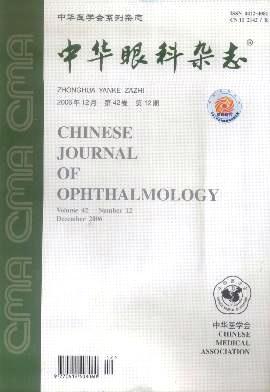[HIF-1信号通路在OPTN (E50K)突变致视网膜神经节细胞损伤中的作用]。
摘要
目的:探讨缺氧诱导因子-1 (HIF-1)通路在OPTN (E50K)突变致大鼠视网膜前体R28细胞损伤中的作用及机制。方法:实验时间为2023年11月~ 2024年10月。提取18月龄野生型(WT)小鼠和OPTN (E50K)突变的正常张力型青光眼小鼠视网膜进行蛋白质组学分析。用腺相关病毒转染R28细胞,构建了携带绿色荧光蛋白(GFP)、GFP- optn (WT)和GFP- optn (E50K)基因的体外模型。采用Western blotting和PCR检测凋亡指数b淋巴细胞-2相关X蛋白(BAX)、HIF-1α和葡萄糖转运蛋白1 (GLUT1)、乳酸脱氢酶A (LDHA)等能量代谢酶的蛋白和mRNA表达。HIF-1α抑制剂Lificiguat分别以0、25、50、75和100 μmol/L的浓度作用于R28细胞12、24和48 h。根据细胞计数试剂盒-8检测结果,选择75 μmol/L Lificiguat作用细胞24小时。检测添加Lificiguat后HIF-1α、GLUT1、LDHA和BAX蛋白及mRNA表达的变化。统计学分析采用单因素方差分析和Tukey检验。结果:实验组小鼠视网膜与对照组相比有1 564个差异表达蛋白,这些蛋白在HIF-1信号通路中显著富集。OPTN (E50K)突变体R28细胞中BAX、HIF-1α、GLUT1和LDHA的蛋白表达水平分别为1.28±0.15、1.54±0.21、1.28±0.15和1.20±0.16。与转染GFP-OPTN (WT)基因的R28细胞相比(0.96±0.04,0.87±0.07,0.90±0.10,0.87±0.02)显著增加;所有POPTN (E50K)突变体R28细胞分别为1.20±0.06,2.89±0.21,2.37±0.22和1.27±0.22)。与转染GFP-OPTN (WT)基因的R28细胞相比,它们也显著增加(0.87±0.14,0.88±0.23,1.24±0.18,0.94±0.07);Lificiguat处理的所有POPTN (E50K)突变体R28细胞分别为0.62±0.11,0.65±0.15和0.76±0.03。与未加Lificiguat处理的OPTN (E50K)突变体R28细胞相比,它们显著降低(0.88±0.04,0.92±0.04,1.08±0.07);与未加Lificiguat处理的POPTN (E50K)突变体R28细胞相比,它们分别为1.06±0.06,1.11±0.14和1.01±0.01。与未加Lificiguat的OPTN (E50K)突变体R28细胞相比,mRNA表达量显著降低(1.34±0.09,1.45±0.14,1.12±0.00);未加Lificiguat和加Lificiguat的POPTN (E50K)突变体R28细胞mRNA表达量分别为0.99±0.10和1.09±0.01,mRNA表达量分别为1.23±0.06和1.31±0.13。在OPTN (E50K)突变体R28细胞中,Lificiguat处理后GLUT1蛋白和mRNA的表达略有升高,但差异无统计学意义(P < 0.05)。结论:OPTN (E50K)突变通过调控HIF-1通路影响R28细胞能量代谢酶GLUT1和LDHA的表达,诱导R28细胞凋亡。Lificiguat能有效抑制OPTN (E50K)突变引起的HIF-1α过表达,保护R28细胞。Objective: To explore the role and mechanism of the hypoxia-inducible factor-1 (HIF-1) pathway in rat retinal precursor R28 cell injury caused by the OPTN (E50K) mutation. Methods: This experimental study was conducted from November 2023 to October 2024. The retinas of 18-month-old wild-type (WT) mice and normal tension glaucoma mice with the OPTN (E50K) mutation were extracted for proteomic analysis. In vitro models carrying the genes of green fluorescent protein (GFP), GFP-OPTN (WT) and GFP-OPTN (E50K) were constructed by transfecting R28 cells with adeno-associated viruses. Western blotting and PCR were used to detect the protein and mRNA expressions of apoptotic index B-lymphocytoma-2-associated X protein (BAX), HIF-1α, and energy metabolism enzymes including glucose transporter 1 (GLUT1) and lactate dehydrogenase A (LDHA). R28 cells were treated with the HIF-1α inhibitor Lificiguat at concentrations of 0, 25, 50, 75 and 100 μmol/L for 12, 24 and 48 hours, respectively. According to the cell counting kit-8 detection results, 75 μmol/L Lificiguat was selected to treat the cells for 24 hours. The protein and mRNA expression changes of HIF-1α, GLUT1, LDHA and BAX were detected after the addition of Lificiguat. The statistical analysis was performed using the one-way analysis of variance and Tukey test. Results: There were 1 564 differentially expressed proteins in the retinas of mice in the experimental group compared with those in the control group, and these were significantly enriched in the HIF-1 signaling pathway. The protein expression levels of BAX, HIF-1α, GLUT1 and LDHA in OPTN (E50K) mutant R28 cells were 1.28±0.15, 1.54±0.21, 1.28±0.15 and 1.20±0.16, respectively. They were significantly increased compared with those in R28 cells transfected with the GFP-OPTN (WT) gene (0.96±0.04, 0.87±0.07, 0.90±0.10, 0.87±0.02; all P<0.05). The mRNA expression levels of BAX, HIF-1α, GLUT1 and LDHA in OPTN (E50K) mutant R28 cells were 1.20±0.06, 2.89±0.21, 2.37±0.22 and 1.27±0.22, respectively. They were also significantly increased compared with those in R28 cells transfected with the GFP-OPTN (WT) gene (0.87±0.14, 0.88±0.23, 1.24±0.18, 0.94±0.07; all P<0.05). The protein expression levels of HIF-1α, LDHA and BAX in OPTN (E50K) mutant R28 cells treated with Lificiguat were 0.62±0.11, 0.65±0.15 and 0.76±0.03, respectively. They were significantly decreased compared with those in OPTN (E50K) mutant R28 cells untreated with Lificiguat (0.88±0.04, 0.92±0.04, 1.08±0.07; all P<0.05). The mRNA expression levels of HIF-1α, LDHA and BAX in OPTN (E50K) mutant R28 cells treated with Lificiguat were 1.06±0.06, 1.11±0.14 and 1.01±0.01, respectively. They were also significantly decreased compared with those in OPTN (E50K) mutant R28 cells untreated with Lificiguat (1.34±0.09, 1.45±0.14, 1.12±0.00; all P<0.05). The protein expression levels of GLUT1 in OPTN (E50K) mutant R28 cells without and with Lificiguat were 0.99±0.10 and 1.09±0.01, while the mRNA expression levels were 1.23±0.06 and 1.31±0.13, respectively. The expression of the GLUT1 protein and mRNA in OPTN (E50K) mutant R28 cells slightly increased after treatment with Lificiguat, and there was no statistically significant difference (all P>0.05). Conclusions: The OPTN (E50K) mutation affects the expression of energy metabolism enzymes GLUT1 and LDHA in R28 cells by regulating the HIF-1 pathway, inducing apoptosis of R28 cells. Lificiguat can effectively inhibit the overexpression of HIF-1α caused by the OPTN (E50K) mutation and protect R28 cells.

 求助内容:
求助内容: 应助结果提醒方式:
应助结果提醒方式:


